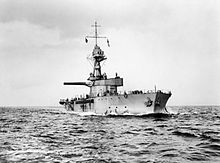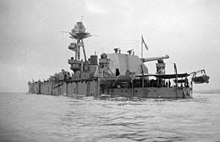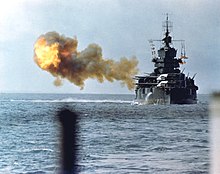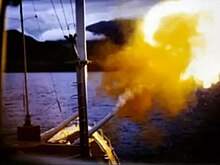
A cruiser is a type of warship. Modern cruisers are generally the largest ships in a fleet after aircraft carriers and amphibious assault ships, and can usually perform several operational roles from search-and-destroy to ocean escort to sea denial.

USS New Jersey (BB-62) is an Iowa-class battleship, and was the second ship of the United States Navy to be named after the U.S. state of New Jersey. She was often referred to fondly as "Big J". New Jersey earned more battle stars for combat actions than the other three completed Iowa-class battleships, and was the only US battleship used to provide gunfire support during the Vietnam War.

USS Tennessee (BB-43) was the lead ship of the Tennessee class of dreadnought battleships built for the United States Navy in the 1910s. The Tennessee class was part of the standard series of twelve battleships built in the 1910s and 1920s, and were developments of the preceding New Mexico class. They were armed with a battery of twelve 14-inch (356 mm) guns in four three-gun turrets. Tennessee served in the Pacific Fleet for duration of her peacetime career. She spent the 1920s and 1930s participating in routine fleet training exercises, including the annual Fleet Problems, and cruises around the Americas and further abroad, such as a goodwill visit to Australia and New Zealand in 1925.

USS Indiana (BB-58) was the second of four South Dakota-class fast battleships built for the United States Navy in the 1930s. The first American battleships designed after the Washington treaty system began to break down in the mid-1930s, they took advantage of an escalator clause that allowed increasing the main battery to 16-inch (406 mm) guns, but refusal to authorize larger battleships kept their displacement close to the Washington limit of 35,000 long tons (35,562 t). A requirement to be armored against the same caliber of guns as they carried, combined with the displacement restriction, resulted in cramped ships, a problem that was exacerbated as wartime modifications that considerably strengthened their anti-aircraft batteries significantly increased their crews.

USS Maryland (BB-46), also known as "Old Mary" or "Fighting Mary" to her crewmates, was a Colorado-class battleship. She was the third ship of the United States Navy to be named in honor of the seventh state. She was commissioned in 1921, and serving as the flagship of the fleet, cruised to Australia, New Zealand, and Brazil.

USS West Virginia (BB-48) was the fourth dreadnought battleship of the Colorado class, though because Washington was cancelled, she was the third and final member of the class to be completed. The Colorado class proved to be the culmination of the standard-type battleship series built for the United States Navy in the 1910s and 1920s; the ships were essentially repeats of the earlier Tennessee design, but with a significantly more powerful main battery of eight 16-inch (406 mm) guns in twin-gun turrets. West Virginia was built between her keel laying in 1920 and her commissioning into the Navy in 1923. The ship spent the 1920s and 1930s conducting routine training exercises, including the typically-annual Fleet Problems, which provided invaluable experience for the coming war in the Pacific.

A warship or combatant ship is a ship that is built and primarily intended for naval warfare. Usually they belong to the armed forces of a nation. As well as being armed, warships are designed to withstand damage and are typically faster and more maneuverable than merchant ships. Unlike a merchant ship, which carries cargo, a warship typically carries only weapons, ammunition and supplies for its crew. Warships usually belong to a navy, though they have also been operated by individuals, cooperatives and corporations.
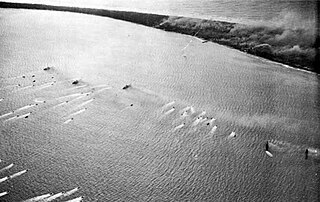
The Battle of Eniwetok was a battle of the Pacific campaign of World War II, fought from 17 to 23 February 1944 on Enewetak Atoll in the Marshall Islands. The invasion of Eniwetok followed the American success in the Battle of Kwajalein to the southeast. Capture of Eniwetok would provide an airfield and harbor to support attacks on the Mariana Islands to the northwest. The operation was officially known as "Operation Catchpole" and was a three-phase operation involving the invasion of the three main islands in the Enewetak Atoll.

USS Forrest Royal (DD-872) was a United States Navy Gearing-class destroyer constructed following the end of World War II. The ship saw service in the Korean War and the Vietnam War before being sold to Turkey in 1971. The ship was renamed TCG Adatepe and remained in service until being scrapped in 1993.

Coastal artillery is the branch of the armed forces concerned with operating anti-ship artillery or fixed gun batteries in coastal fortifications.
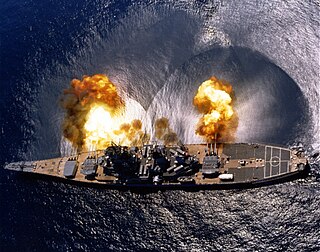
Naval artillery is artillery mounted on a warship, originally used only for naval warfare and then subsequently used for more specialized roles in surface warfare such as naval gunfire support (NGFS) and anti-aircraft warfare (AAW) engagements. The term generally refers to powder-launched projectile-firing weapons and excludes self-propelled projectiles such as torpedoes, rockets, and missiles and those simply dropped overboard such as depth charges and naval mines.
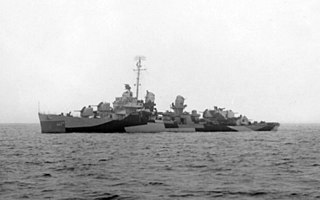
USS Heywood L. Edwards (DD-663) was a Fletcher-class destroyer of the United States Navy, named after Lieutenant Commander Heywood L. Edwards (1905–1941), captain of the destroyer USS Reuben James, the first U.S. Navy ship sunk in World War II. Following the war, the ship was transferred to Japan and renamed Ariake. The ship served with the Japanese until 1974 and was scrapped in 1976.

The blockade of Wonsan, or the siege of Wonsan, from February 16, 1951, to July 27, 1953, during the Korean War, was the longest naval blockade in modern history, lasting 861 days. United Nations naval forces, primarily from the United States, kept the strategically important city of Wonsan from being used by the North Korea Navy.

The QF 3-pounder Hotchkiss or in French use Canon Hotchkiss à tir rapide de 47 mm were a family of long-lived light 47 mm naval guns introduced in 1886 to defend against new, small and fast vessels such as torpedo boats and later submarines. There were many variants produced, often under license which ranged in length from 32 to 50 calibers but 40 caliber was the most common version. They were widely used by the navies of a number of nations and often used by both sides in a conflict. They were also used ashore as coastal defense guns and later as an anti-aircraft gun, whether on improvised or specialized HA/LA mounts.
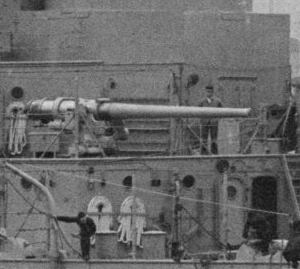
5"/51 caliber guns initially served as the secondary battery of United States Navy battleships built from 1907 through the 1920s, also serving on other vessels. United States naval gun terminology indicates the gun fired a projectile 5-inch (127 mm) in diameter, and the barrel was 51 calibers long.

The United States battleship retirement debate was a debate among the United States Navy, Marine Corps, Congress, and independent groups over the effectiveness of naval gunfire support (NGFS) provided by Iowa-class battleships, and whether or not an alternative should be implemented. The debate centered on the best way to provide fire support for amphibious assault and other troops near a shoreline.
The Fleet Landing Exercises, or FLEX were amphibious landing exercises conducted by the United States Navy and United States Marine Corps between 1935 and 1941. The purpose of these exercises was to formulate a workable amphibious warfare doctrine. The development of the necessary craft and other equipment, and the proper tactical deployment of them were also results. Finally, the exercises demonstrated the usefulness of a standing body of Marines, the Fleet Marine Force, specially prepared for amphibious expeditions.

Ship gun fire-control systems (GFCS) are analogue fire-control systems that were used aboard naval warships prior to modern electronic computerized systems, to control targeting of guns against surface ships, aircraft, and shore targets, with either optical or radar sighting. Most US ships that are destroyers or larger employed gun fire-control systems for 5-inch (127 mm) and larger guns, up to battleships, such as Iowa class.

During the last weeks of World War II, warships of the United States Navy, the Royal Navy and the Royal New Zealand Navy bombarded industrial and military facilities in Japan. Most of these bombardments were conducted by battleships and cruisers, and caused heavy damage to several of the targeted factories, as well as nearby civilian areas. A major goal of the attacks was to provoke the Japanese military into committing some of its reserve force of aircraft into battle. However, the Japanese did not attempt to attack the Allied bombardment forces, and none of the involved warships suffered any damage.

The bombardment of Cherbourg took place on June 25, 1944, during World War II, when ships from the United States Navy and the British Royal Navy attacked German fortifications in and near the city, firing in support of U.S. Army units that were engaged in the Battle of Cherbourg. In doing so, the Allied naval forces engaged in a series of duels with coastal batteries and provided close support to infantry as they fought to gain control of the city. The bombardment was initially scheduled to last just two hours but it was later extended by an hour to support army units attempting to break into Cherbourg's city streets. After the bombardment, German resistance lasted until June 29, when the port was captured by the Allies. Afterwards, the task of clearing the port for use lasted several weeks.

